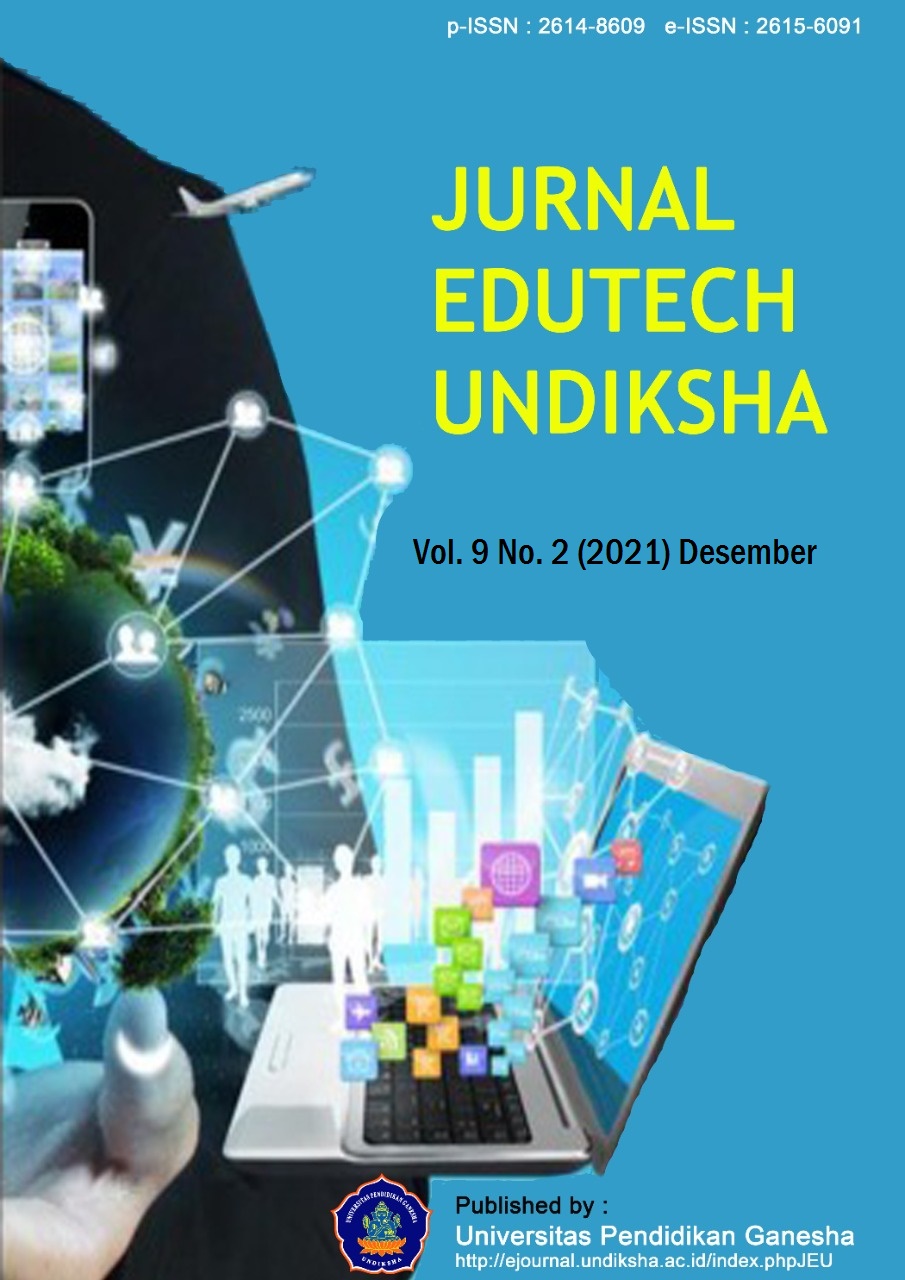Quality of Service pada Virtual Local Area Network
DOI:
https://doi.org/10.23887/jeu.v9i2.39825Keywords:
VLAN, RTT, Packet Loss, TTLAbstract
VLAN adalah bagian jaringan yang independen secara logika. Paket menghabiskan banyak waktu berpindah ke tujuan dan sering berubah. Kualitas jaringan yang tidak baik dan alamat yang akan dituju memiliki delay yang tinggi. Oleh karena itu, jaringan ini dapat dikatakan tidak stabil. Tujuan penelitian ini yaitu untuk merancang sebuah sistem jaringan. Layanan internet di sekolah ini menggunakan Internet Service Provider (ISP). Jenis penelitian ini yaitu pengembangan. Metode perancangan yang dilakukan dalam penelitian menggunakan metode PPDIOO. Fase-fase yang ada dalam metode PPDIOO ini adalah Plan, Prepare, Design, Implement, Operate, Optimize. Metode yang digunakan untuk mengumpulkan data yaitu kuesioner, observasi, dan wawancara. Instrumen yang digunakan dalam penelitian ini yaitu kuesioner. Teknik yang digunakan untuk menganalisis data yaitu analisis deskriptif kualitatif dan kuantitatif. Hasil penelitian menunjukkan bahwa perancangan jaringan virtual local area network (VLAN) didapatkan mean round-trip time tertinggi sebesar 19,16 ms. Jadi, rata-rata packet loss rate adalah 2,64%, hasil packet loss 2,64% termasuk dalam kategori (sangat baik). Selain itu, median survival time adalah 126,5 ms, sehingga dari hasil pengujian ini, perancangan virtual local area network (VLAN) layak untuk diimplementasikan.
References
Bhardwaj, T., & Sharma, S. C. (2018). Cloud-WBAN: An Experimental Framework for Cloud-enabled Wireless Body Area Network with Efficient Virtual Resource Utilization. Sustainable Computing: Informatics and Systems, 20. https://doi.org/10.1016/j.suscom.2018.08.008.
Burik, A. (2021). Using Technology to Help Students Set, Achieve, and Publicize Goals. Adult Literacy Education: The International Journal of Literacy, Language, and Numeracy, 3(1), 83–89. https://doi.org/10.35847/aburik.3.1.83.
Dina, A. S., & Manivannan, D. (2021). Intrusion Detection Based on Machine Learning Techniques in Computer Networks. Internet of Things, 16. https://doi.org/10.1016/j.iot.2021.100462.
Gunawan, I. K., Sukmana, H. T., & Ardianto, A. Y. (2021). Blockchain Technology as A Media for Sharing Information that Generates User Access Rights and Incentives. Blockchain Frontier Technology, 1(01), 44–55. https://doi.org/10.3389/fbloc.2020.497985.
Hailu, D. H., Lema, G. G., Gebrehaweria, B. G., & Kebede, S. H. (2020). Quality of Service (QoS) Improving Schemes in Optical Networks. Heliyon, 6(4). https://doi.org/10.1016/j.heliyon.2020.e03772.
Hertanto, D. B. (2021). Upaya Peningkatan Kualitas Kuliah Jaringan Komputer melalui Penerapan Media Pembelajaran Packet Tracer 5.0. Jurnal Pendidikan Teknologi Dan Kejuruan Dan Kejuruan, 20(1). https://doi.org/10.21831/jptk.v20i1.7753.
Kumar, B. V., Ahmed, S. M., & Prasad, M. N. G. (2021). Efficient Method to Identify Hidden Node Collision and Improving Quality-of-Service (QoS) in Wireless Sensor Networks. Materials Today: Proceedings. https://doi.org/10.1016/j.matpr.2021.05.498.
Li, X., Ji, L., Zhu, H., Li, P., Jia, X., & Li, C. (2021). Cellular Automata-Based Simulation of Cross-Space Transmission of Energy Local Area Network Risks: A Case Study of A Power Supply Station in Beijing. Sustainable Energy, Grids and Networks, 27. https://doi.org/10.1016/j.segan.2021.100521.
Moedjahedy, J. (2016). Implementasi Point to Point Jaringan Internet Nirkabel Di SMA Universitas Klabat. Gogita Smart Journal, 2(2). https://doi.org/10.31154/cogito.v2i2.33.240-249.
Nourildean, S. W., Salih, A. M., & Othman, K. M. Z. (2021). AODV, DSR and OLSR Routing Protocols Investigation on Virtual Local Area Network. Materials Today: Proceedings. https://doi.org/10.1016/j.matpr.2021.01.089.
Nugroho, K., & Kurniawan, A. Y. (2018). Uji Performansi Jaringan Menggunakan Kabel UTP dan STP. Jurnal Elkomika, 5(1). https://doi.org/10.26760/elkomika.v5i1.48.
Ogelman, H. G., Gungor, H., Korukcu, O., & Sarkaya, H. E. (2018). Examination of the Relationship Between Technology Use of 5–6 Year-Old Children and Their Social Skills and Social Status. Early Child Development and Care, 188(2), 168–182. https://doi.org/10.1080/03004430.2016.1208190.
Qiang, T. (2021). Engineering Design of Electronic Fence System Based on Intelligent Monitoring and Wireless Local Area Network. Alexandria Engineering Journal. https://doi.org/10.1016/j.aej.2021.08.019.
Rohman, Q. A. H. H., & Salahuddin, N. S. (2018). Rancang Bangun Prototipe Mobil Penjelajah dengan Kendali Jarak Jauh melalui Jaringan Wi-Fi Berbasis Antarmuka Web. Teknika, 7(1). https://doi.org/10.34148/teknika.v7i1.79.
Rupilele, frits gerit john, & Palilu, A. (2019). Rancang Bangun Sistem Informasi Manajemen Pengaduan Masyarakat dan Monitoring Kinerja Akademik Perguruan Tinggi. Jurnal Sisfokom, 8(2). https://doi.org/10.32736/sisfokom.v8i2.672.
Schrammel, H., Kelz, J., Gruber-Glatzl, W., Halmdienst, C., & Schröttner, J. (2021). Increasing Flexibility towards a Virtual District Heating Network. Energy Reports, 7(4). https://doi.org/10.1016/j.egyr.2021.08.075.
Shandilya, S. K., Upadhyay, S., Kumar, A., & Nagar, A. K. (2022). AI-Assisted Computer Network Operations testbed for Nature-Inspired Cyber Security Based Adaptive Defense Simulation and Analysis. Future Generation Computer Systems, 127. https://doi.org/10.1016/j.future.2021.09.018.
Slimen, Y. Ben, Balcerzak, J., Pagès, A., Agraz, F., Spadaro, S., & Koutsopoulos, K. (2021). Quality of Perception Prediction in 5G Slices for E-Health Services using User-Perceived QoS. Computer Communications, 178. https://doi.org/10.1016/j.comcom.2021.07.002.
Solikin, I. (2017). Penerapan Metode PPDIOO dalam Pengembangan LAN dan WLAN. Jurnal Teknologi Dan Informatika, 7(1). http://ojs.palcomtech.ac.id/index.php/teknomatika/article/view/34.
Toyoda, Y., Muranaka, A., Kim, D., & Kanegae, H. (2021). Framework for Utilizing Disaster Learning Tools Classified by Real and Virtual Aspects of Community Space and Social Networks: Application to Community-Based Disaster Risk Reduction and School Disaster Education on Earthquakes in Japan for During- and Pos. Progress in Disaster Science, 12. https://doi.org/10.1016/j.pdisas.2021.100210.
Tulloh, R., Negara, R. M., & Hidayat, A. N. (2015). Simulasi Virtual Local Area Network (VLAN) Berbasis Software Defined Network (SDN) Menggunakan POX Controller. Jurnal Infotel, 7(2). https://doi.org/10.20895/infotel.v7i2.40.
Wongkar, S., Sinsuw, A., & Najoan, X. (2015). Analisis Implementasi Jaringan Internet dengan Menggabungkan Jaringan Lan dan Wlan di Desa Kawangkoan Bawah Wilayah Amurang II. Jurnal Teknik Elektro Dan Komputer, 4(6), 62–68. https://doi.org/10.35793/jtek.4.6.2015.10400.
Zaus, M. A., & Krismadinata, K. (2018). Suatu Kajian Literatur Masalah-Masalah yang Dihadapi dalam Mata Kuliah Jaringan Komputer. INVOTEK: Jurnal Inovasi Vokasional Dan Teknologi, 18(2), 1–8. https://doi.org/10.24036/invotek.v18i2.263.
Zhu, X., & Luo, S. (2021). The Influence of Computer Network Technology on National Income Distribution Under the Background of Social Economy. Computer Communications, 177. https://doi.org/10.1016/j.comcom.2021.06.025.
Downloads
Published
How to Cite
Issue
Section
License
Authors who publish with the Jurnal Edutech Undiksha (JEU) agree to the following terms:
- Authors retain copyright and grant the journal the right of first publication with the work simultaneously licensed under an Attribution-ShareAlike 4.0 International (CC BY-SA 4.0) that allows others to share the work with an acknowledgment of the work's authorship and initial publication in this journal.
- Authors are able to enter into separate, additional contractual arrangements for the non-exclusive distribution of the journal's published version of the work (e.g., post it to an institutional repository or publish it in a book), with an acknowledgment of its initial publication in this journal.
- Authors are permitted and encouraged to post their work online (e.g., in institutional repositories or on their website) prior to and during the submission process, as it can lead to productive exchanges, as well as earlier and greater citation of published work. (See The Effect of Open Access)








